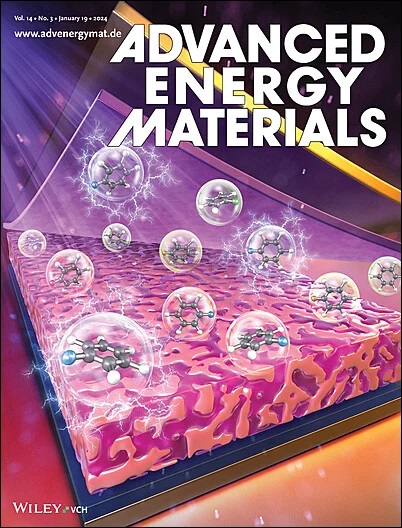Electric Field Sponge Effect of Conducting Polymer Interphases Boosts the Kinetics and Stability of Zinc Metal Anodes
IF 24.4
1区 材料科学
Q1 CHEMISTRY, PHYSICAL
引用次数: 0
Abstract
Aqueous zinc (Zn) batteries (AZBs) are regarded as a prime choice for large-scale energy storage due to their high safety and low cost. Nevertheless, the issues of Zn dendrites and side reactions seriously limit the cycling stability of AZBs. Herein, it is found that the electric field sponge effect of poly (3,4-ethylenedioxythiophene) (PEDOT) as a model conducting polymer interphase can boost the kinetics and stability of Zn anodes. During Zn2+ plating, the electron-rich conjugated π─π bonds can accelerate Zn2+ migration and reduction. During Zn2+ stripping, the electron-deficient conjugated π─π bonds can promote Zn2+ transfer from the Zn substrate into electrolytes. The Coulombic attractive/repulsive force-regulated Zn2+-plating/stripping behavior is similar to the absorbing/squeezing processes of water from sponges, so the electric field sponge effect is proposed. This concept applies to other conducting polymer interphases, such as polyaniline and polypyrrole. Moreover, the presence of conducting polymer interphases effectively suppresses the water-induced side reactions on Zn. Consequently, the Zn@PEDOT electrode manifests a superior long lifespan of 5250 h (1 and 1 mAh cm−2) and an ultra-high current density tolerance of 80 mA cm−2 and assures the coin-type and pouch-type Zn-based full batteries with excellent cycling stability.

求助全文
约1分钟内获得全文
求助全文
来源期刊

Advanced Energy Materials
CHEMISTRY, PHYSICAL-ENERGY & FUELS
CiteScore
41.90
自引率
4.00%
发文量
889
审稿时长
1.4 months
期刊介绍:
Established in 2011, Advanced Energy Materials is an international, interdisciplinary, English-language journal that focuses on materials used in energy harvesting, conversion, and storage. It is regarded as a top-quality journal alongside Advanced Materials, Advanced Functional Materials, and Small.
With a 2022 Impact Factor of 27.8, Advanced Energy Materials is considered a prime source for the best energy-related research. The journal covers a wide range of topics in energy-related research, including organic and inorganic photovoltaics, batteries and supercapacitors, fuel cells, hydrogen generation and storage, thermoelectrics, water splitting and photocatalysis, solar fuels and thermosolar power, magnetocalorics, and piezoelectronics.
The readership of Advanced Energy Materials includes materials scientists, chemists, physicists, and engineers in both academia and industry. The journal is indexed in various databases and collections, such as Advanced Technologies & Aerospace Database, FIZ Karlsruhe, INSPEC (IET), Science Citation Index Expanded, Technology Collection, and Web of Science, among others.
 求助内容:
求助内容: 应助结果提醒方式:
应助结果提醒方式:


